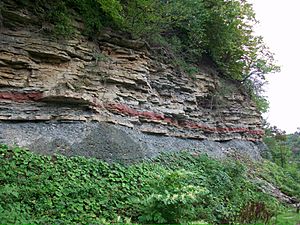Clinton Group facts for kids
Quick facts for kids Clinton GroupStratigraphic range: Early Silurian |
|
|---|---|

Rocks of the Clinton Group on the east face of Schuylkill Gap
|
|
| Type | Geological formation |
| Sub-units | Rochester Shale, Rose Hill Formation, Keefer Formation |
| Underlies | Bloomsburg Formation in Pennsylvania, Lockport Group in New York |
| Overlies | Tuscarora Formation in Pennsylvania, Clinch Formation in Virginia, Tennessee, and Maryland, Medina Group in New York |
| Thickness | 1640 ft |
| Lithology | |
| Primary | sandstone, shale, and limestone |
| Other | Ironstone and conglomerate, |
| Location | |
| Region | Appalachian Basin of eastern North America |
| Country | United States |
| Extent | Pennsylvania, Maryland, New York, West Virginia |
| Type section | |
| Named for | Clinton, New York |
| Named by | Lardner Vanuxem (1842) |
The Clinton Group is a special set of sedimentary rock layers found across eastern North America. Imagine looking at a stack of books; each book is a different rock layer. The Clinton Group is like a few of those books stacked together.
A geologist named Lardner Vanuxem first described these rocks in 1842. He named them after the village of Clinton in New York, where you can see these rock layers very clearly.
These rocks are part of a huge area called the Appalachian Basin. This basin stretches from New York all the way down to Alabama. You can find rocks from the Clinton Group in many states, including Kentucky, Maryland, New York, Ohio, Pennsylvania, Tennessee, Virginia, and West Virginia.
The Clinton Group is important because it holds many fossils. These fossils tell us a lot about the sea creatures that lived during the early Silurian Period, which was about 443 to 419 million years ago! These rocks also contain valuable materials, especially iron ore, which has been mined for a long time.
Contents
Where the Clinton Group Sits in the Earth's Layers
Think of the Earth's crust as a giant layer cake. The Clinton Group is one of the layers in this cake.
In New York, the Clinton Group sits on top of older rock layers like the Medina Group. In Pennsylvania, it's above the Tuscarora Formation. In other places like Virginia and West Virginia, it's above the Clinch Sandstone.
Above the Clinton Group, you'll find younger rock layers. In New York, it's covered by the Lockport Group. In Pennsylvania, the McKenzie Formation lies on top.
Because the Clinton Group rocks are softer than the hard rocks above them, they wear away more easily. This difference in hardness has helped create famous waterfalls like Niagara Falls and the High Falls in Rochester, New York. These waterfalls are part of a larger natural feature called the Niagara Escarpment.
What is the Clinton Group Made Of?
The Clinton Group is mostly made of shale and mudstone. Shale is a type of rock made from hardened mud. But it also includes many other kinds of rocks. You can find conglomerate (rock made of pebbles), sandstone (made of sand), limestone (made from shells and sea creatures), dolomite (another type of limestone), and ironstone (rock rich in iron).
In its original discovery area near Clinton, Oneida County, New York, the Clinton Group is about 50 meters (180 feet) thick. Here, it's mostly blue-gray mudstone, shale, and sandstone. It also has several layers rich in iron, which are known as "Clinton Ironstones." South of New York, in Pennsylvania, a similar rock unit called the Rose Hill Formation is found. It's often olive-gray and made of thin layers of sandstone.

How Was the Clinton Group Used?
The rocks of the Clinton Group have been important for their valuable resources. One of the most important is iron ore. This ore was used to make iron and steel, which were vital for building cities, railroads, and machines. For example, in Maryland, a part of the Rose Hill Formation called the Cresaptown Iron Sandstone was a source of iron.
How Old is the Clinton Group?
Scientists use different methods to figure out the age of rock layers. Based on these methods, the Clinton Group formed during the early part of the Silurian Period. This means these rocks are very old, dating back millions of years!
The Clinton Group sits directly on top of the Tuscarora Formation and below the Lockport Group and Bloomsburg Formation. This helps geologists understand the order of rock layers in the Earth's history.

